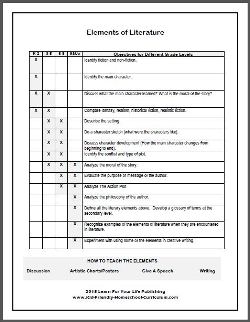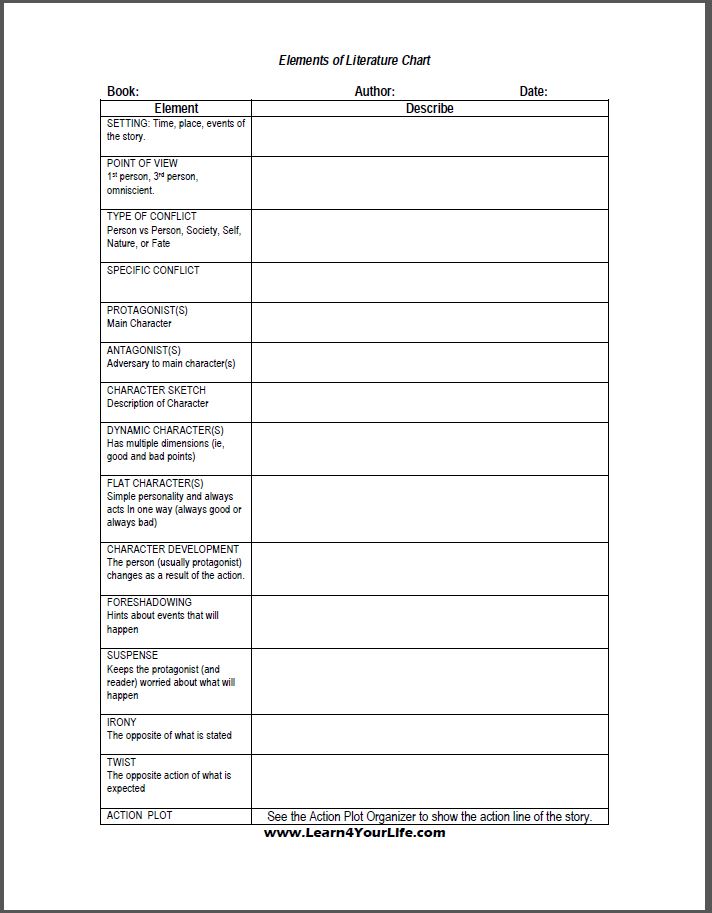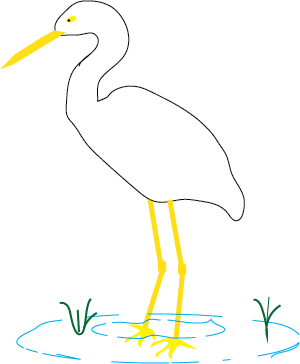
Elements of Literature Handout
The elements of literature are at the heart of every literary study. Classic literature is more than just a good story; it is artwork that uses these literary elements to reflect human nature.

Free Student Handout Below
Identify the Elements of Literature
These are the 14 elements of literature listed on the handout
Below are the fourteen different elemenst of literature with a brief explanation. Just for the fun of it, we list in italics the elements for a particularly famous tale; though we will let you see if you can identify it.Setting
The setting is the time and location of the story. The setting would also include any well-known events that provide the backdrop of the story (for instance, the sailing of the Mayflower, the Oregon trail, or Apollo 13.)Example: The setting is the forest in the eighteenth century A.D.
Point Of View
The point of view identifies how and by whom the reader will see the action.- First Person: a narrator tells the story using "I", "me", and "we."
- 1st Person Primary: Most of the time the first person narrator is the main character.
- 1st Person Secondary: Here the narrator is NOT the main person. For instance, in the Sherlock Holmes stories, his assistant Dr. Watson is the narrator so you see the action but you don't know what the detective is thinking until he announces the solution.
- 1st Person Tertiary: Here the narrator is a minor character or unknown character. In the English novel, Wuthering Heights, a very minor person outside the circle of characters acts as the first person narrator.
- 3rd Person: There is no narrator. You see only what the main character is doing and thinking. The story is told using "he" or "she." This is the most common point of view in stories. It is as if the reader has a camera focused on the main character and can see and feel with that character.
- 3rd Person Omniscient: Sometimes called the bird's eye view because the reader is looking from above and knows more than the main character.
- 3P Omniscient Complete: The reader knows all, including what multiple characters see, think, and do.
- 3P Omniscient Partial: The reader occasionally gets a hint what others think, see, or do and hence knows a little more than the main character.
Types of Conflict
There are five main types of conflict in stories.- Person vs Person - The most common conflict. One person is in a conflict with another person or persons.
- Person vs Nature - Adventure stories often have the main character pitted against a force of nature, like a blizzard, storm at sea, drought, or other disaster.
- Person vs Society - The norms of society may cause the confict that the main character is up against.
- Person vs Self - the main character's own beliefs or ideas may be in conflict with other goals they have. Sometimes this is a minor conflit set within a major conflict.
- Person vs Fate or Time or God - The forces working against the main character are greater than individuals or society or even nature.
Example: In our example the conflict is person(s plural) vs person (singular). In this case, talking animals are considered persons.
Protagonist(s)
The protagonist is the main character or characters.In our example, there are three protragonists who do not have names. They are three brothers from the swine family.
Antagonist(s)
This is the bad guy or bad guys. They could be an utterly villainous specimen of humanity, or it might be the protagonist(s) best friend who is not supporting him or her in an important decision. The antagonist is the adversary.Example: The antagonist in our tale is a large, evil member of the canis lupus family; often called by the name of Big Bad Wolf.
Character Sketch
The character sketch is a description of the characters. While it does include physical characterstics, age, and other obvious identities, it is much more. In true classic literature the author creates a character with a mixture of ideas, goals, and dreams. The character sketch includes who they are, who they want to be, and who others see them as. True literature differs from popular literature by the complexity and realism of the character sketches.While the character sketch is usually applied to the main character, it also applied to other characters - even minor ones. Often we see the character sketch of the antagonist: what internal and external forces have turned this person into an adversary.
Charles Dickens was a master at creating unique and complex characters. Taking the time to really look at the characters and what motivates them makes the study of literature more entertaining and insightful to the student.
In our story example, the characters are two short-sighted brothers and one far-sighted bother; all of whom are setting out to begin an independent life for themselves. In spite of their desire for independence, they maintain a family spirit of inter-dependence which saves them.
Dynamic Characters
Dynamic characters are also called round characters. They have strengths and weaknesses and a complex character sketch. Their personality is often a mixture of altruistic - or unselfish goals - as well as selfish ones.Dynamic characters make the story interesting as well as more realistic. (Few people are really all good or all bad.) You never know exactly what they are going to do which may add to the building suspense.
Two of the main characters in our story are not very round. Well, yes they have a rounded shape, but they are simple-minded and do exactly what is expected. The third brother shows more complexity and fore-sight. In reality, this story is a very poor example of either dynamic characters, character sketch, or character development.
Flat Characters
Flat charcters have only one dimension - which may be good, bad, silly, stupid, or another quality. The author does not provide much effort or word space to develop them, either because they are too shallow to be developed or because the author is using them to fulfill a specific role. A friend like Klara in the book Heidi is a flat character, as she is always kind and gentle.In our example the first two brothers and the Big Bad Wolf are all flat, unchanging characters.
Character Development
Character development is the way and manner in which the main character (and possibly others) change through the story. Their values, insights, and goals change because of the conflict they have gone through.Character development as well as character sketches are one of the most important qualities that distinguish classical literature from popular literature.
The historical fiction stories by G.A. Henty are perhaps a good example of literature that was well written but did not completely make the cut of true classic literature. The main character is all of his books as basically the same personality albeit transposed from one historical epoch to another. He is always a noble, sterling, and unselfish character at the beginning of the book and remains so until the end. While such nobility of character is indeed noble, it does not provide the character development that makes a story a true classic.
In our example, which one by this time should recongize as the THREE LITTLE PIGS, there is relatively little character development. This story is classified as a fairy tale, in which character development is somewhat absent or minimal.
It can be argued then that fairy tales are not classics in one sense. The counter argument is that the underlying story behind the fairy tales is the presence of evil in our society and the changing social values to deal with it. A bit heady for the young tykes reading or watching Cinderella, I'd say. Read What is a Fairy Tale for more insights into this genre.
Foreshadowing
Foreshadowing provides hints of what may happen. These are often hints of bad things to come and may help to build suspense.Often they are stated in such terms as, "She did not know how much pain those words would cause" which alerts the readers to what is coming. Other times it is a less obvious cloud on the horizon, a shadow that the main character missed but the reader recognizes.
Suspense
Suspense is the building action. It keeps the protangoist (and reader) worried about what will happen next.Download the Action Plot Graphic Organizer to chart how the suspense builds with the rising action.
In our example, the suspense builds as the pigs barely escape from the first two houses and they flee to the last house. The climax occurs as the wolf decides to go down the chimney.
Irony
Irony is the opposite of what is stated or expected. Explicit irony often (but not always) includes sarcasm.For example, one could refer to the ingenituity of the first pig in choosing the readily available branches to build his house, or the ever present thoughtfullness of Cinderella's step-sisters.
The irony might not be stated but be part of the plot. For example, the youngest child in a story is the bravest or most insightful.
Twist
A twist is not present in every story, and occurs as often in popular literature as in classical literature. It is the opposite of fairy tales, where one knows from the start that the good guy will "live happily ever after."A twist in the plot occurs when the opposite of what is expected occurs. The main character loses the race, the trusted best friend is the liar, the honored police chief is the murderer.
The author may choose to give little tidbits of foreshadowing to warn the reader of the coming twist, or may spring it as a surprise at the end.
Print the Elements of Literature Handout
Have your printer ready to print the elements of literature handout for your students.


Print our Elements of Literature Student Handout
A new window will open. Have your printer ready.
Other Ways to Share the Elements of Literature
Yes, your students can fill out the handout to show the elements of literature. But here are 5 ways to share elements of literature to add variety to your progrram.













